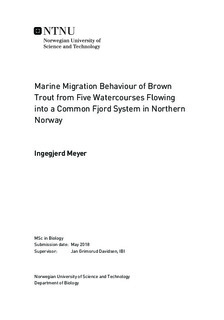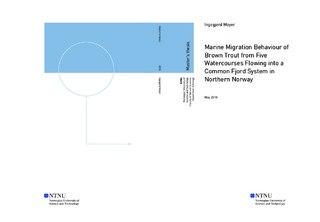| dc.description.abstract | Brown trout is a freshwater fish which exhibits a wide array of life history and migration strategies. These different strategies result in great morphological variation both among and within populations. The aim of the study has been to describe the marine migratory behaviour of five populations of brown trout that all have access to the same fjord system and compare these findings with current theory in the field, with focus on the migration continuum theory of brown trout migration. The marine migration behaviour was studied with acoustic telemetry, and the life histories of the fish through fish scale analysis. In total 137 veteran fish with an assumed or confirmed marine migration were followed for up to two seasons during 2016 and 2017. Difference was seen between the populations, with variation in length-at-age and different ages and sizes of smoltification. Of the fjord migrating fish 65% performed long distance (>19 or >26 km, dependent on watercourses due to difference in receiver locations) migrations and 19% short distance (<15 km) migrations. The different populations varied in the time used to perform a long-distance migration, with a median time of 1.0-5.6 days in 2016 and 2.3-8.5 days in 2017. For 2016, females had a faster outward migration, and Julian day of watercourse exit had a negative correlation with the number of days spent before reaching the limit for long distance migration. In 2017 increasing total length of the fish that had a negative correlation with time to long distance migration. Duration of marine migration was negatively correlated with the Julian day of river exit, and fish from Saltdalselva had a shorter migration duration than other fish. The different populations utilized the fjord in varying amounts, with fish from Botnvassdraget and Saltdalselva utilizing the whole fjord system while fish from Misvær and Valnesfjord remained confined to the watercourse or estuary. In Sulitjelma the tagged fish were split between residing in the watercourse and in the fjord system, with males dominating the former group and females the latter. Difference between migrations strategies was attributed to the availability or not of high-quality marine areas in the vicinity. The results of this study further support the view of migration strategies in brown trout as a continuum, rather than a dichotomy between residents and fjord migrants. The different strategies have been shaped by the selective pressure each population faces and therefore reflections of the challenges the populations face in the watercourse, the estuary and in the fjord system. | |

